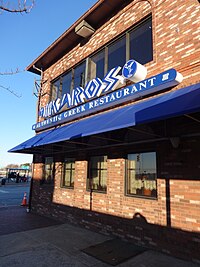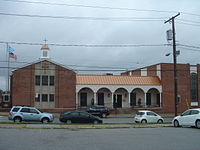User:Sauzer/sandbox16
Greektown | |
|---|---|
 Sign for Greektown, December 2014. | |
| Coordinates: 39°17′07″N 76°33′07″W / 39.285194°N 76.552056°W | |
| Country | United States |
| State | Maryland |
| City | Baltimore |
| Named for | Greek-American ethnic heritage |
Greektown is a neighborhood located in Baltimore, Maryland, United States.
The neighborhood is bounded by Lombard Street to the north, O'Donnell Street to the south, South Haven to the west, and the Yard 56 development to the east. A long stretch of Eastern Avenue runs through the neighborhood. The neighborhood is home to many Greek restaurants and to the Saint Nicholas Greek Orthodox Church. Greektown is home to the annual Baltimore Greek Festival and Parade.
History
[edit]A Greek school was founded in the neighborhood in the 1920s.[2]
The St. Nicholas Greek Orthodox Church has sponsored an annual Greek Folk Festival for decades.[3]
Settled beginning after World War I, the area was home to migrants of German, Irish, Finnish, Italian, Polish and Ukrainian heritage.[4]
A Greek specialty goods importer was open by 1954, a second followed three years later.[5] The first Greek restaurant in the area, Ikaros, opened in 1966, as the population of Greek immigrants continued to increase.[4] By 1979, more restaurants, Greek-style coffee houses, a Greek bakery and deli had clustered along this stretch of Eastern Avenue.[6][7] A Greek-language radio program broadcasted music and other programming to the area.[8] The growing number of Greek business owners, petitioning the city for greater security, formed a "Greektown association," with an ambition that the ethnic enclave could be "another Little Italy [...] with dozens of places for tourists to come."[8]
By the 1980s, the area could be described as "a Greek community transplanted to Baltimore," and the subject of study by a folklorist.[9] By this time, "Greektown" was being identified as a distinct part of greater Highlandtown, encompassing the area between Lehigh Street in the east to Umbra Street in the south, Lombard Street to the north and O'Donnell Street to the south.[10] Disagreement among residents about the neighborhood's name continued however, as a Johns Hopkins University neighborhood researcher observed: "You'd talk to a Greek man and he'd tell you he lives in Greektown, [...] then you'd talk to a Polish man and he'd tell you it was really called Highlandtown. And a German would tell you it was Germantown."[11]
but received a large influx of Greek immigrants beginning around the time of the Greek Civil War in the 1940s.[12] Greektown has been home to a thriving Greek American community since the 1930s.
Historically, the area was considered a part of the larger Highlandtown neighborhood.[13][14][15]
The economy of the area was once supported by the adjacent sprawling Crown Cork & Seal plant, until its closure in the mid-1960s.[13] Other residents worked at plants such as those of Crosse and Blackwell and Bethlehem Steel.[4]
dozens of backyard fig trees[16]
15th Street Improvement Association founded in 1969[17]
GCDC founded a citizen patrol organization[18]
GCDC obtained security cameras along Eastern Avenue.[19]
Once known simply as The Hill[4][9]
'stable' neighborhood into the 80s, with homes maintaining value.[20]
, during the 1980s its residents petitioned the Baltimore City Council to change the name of the neighborhood to Greektown.
Continuing a consecutive-alphabet scheme that originates in Highlandtown to the west, the north–south streets in this area are: Lehigh, Macon, Newkirk, Oldham, Ponca, Quail, Rappolla, Savage, Tolna, and Umbra.
A bridge shot in the Barry Levinson film Diner (at the 21:51 mark) was filmed at Fleet Street and South Newkirk Street, with the Crown Cork and Seal building appearing in the background.
Greektown underwent a revitalization effort beginning in 2001.[21]
estimated 65% Greek in 1996[25]
Demographics
[edit]In 2014 Greektown was home to around 600 families. During the neighborhood's peak there were around 1,000 families.[26] Like Baltimore overall, Greektown's population had gradually declined at the end of the century, from 3,599 residents in 1990 to 3,294 in 2000.[27] But between 2000 and 2010, the population rose to 3,630 people, and by the 2020 census had climbed to 4,757 residents.[28][29]
Today
[edit]
A thriving self-contained residential and business community consisting of single family town houses, Greektown is noted for its many restaurants, authentic Greek coffee houses, bakeries and small businesses of many types. It is a diverse community of largely blue-collar people of numerous ethnic derivations. Greektown is mostly Greek and other European descendants, but also includes large numbers of people of Native American, Asian, African-American and Hispanic (particularly Puerto Ricans, Mexicans, Dominicans, and smaller numbers of Guatemalans and Salvadorans) ancestry living in a low crime environment. The Greektown Community Development Corporation was formed to revitalize Greek town by The St Nicholas Church. The 1000 member church parish council unanimously voted to appoint Col John E Gavrilis as its first Executive Director. Under his leadership a strategic plan to revitalize the community was published.

The neighborhood is served by Dr. John Ruhrah Elementary Middle School, a city-designated landmark building, built in 1930.[30]
John Ruhrah
[edit]a "hulking old building"[31]
half Greek in 1985[31]
Notable Residents
[edit]State Sentator Perry Sfikas[4]
See also
[edit]References
[edit]- ^ Hayward, Mary Ellen (2018-07-01), National Register of Historic Places Registration Form: Greektown Historic District B-1368, Maryland Historical Trust
- ^ Dewar, Heather (2000-03-27). "Old memories in step with annual tradition". The Baltimore Sun. Baltimore, Maryland. p. 13. Retrieved 2023-09-27.
- ^ Schoettler, Carl (1983-06-08). "Hard work turns Greek fest into feast". The Evening Sun. Baltimore, Maryland. p. 21. Retrieved 2023-09-27.
- ^ a b c d e f Scalia, Rosalia (1996-06-30). "Greektown is filled with Old World charm". The Baltimore Sun. Baltimore, Maryland. p. 138. Retrieved 2023-09-27.
- ^ Ollove, Michael (1987-12-02). "In Greektown, Athens is found on store shelves". The Baltimore Sun. Baltimore, Maryland. p. 44. Retrieved 2023-09-27.
- ^ Nugent, Tom (1979-12-21). "Relaxing in Athens East (Baltimore, that is)". The Baltimore Sun. Baltimore, Maryland. p. 25. Retrieved 2023-09-27.
- ^ Nugent (1979-12-21). "Relaxing in Athens East (Baltimore)". The Baltimore Sun. Baltimore, Maryland. p. 27. Retrieved 2023-09-27.
- ^ a b "Jimmy 'the Greek' has got everything from olive to oil". The Baltimore Sun. Baltimore, Maryland. 1979-04-12. p. 32. Retrieved 2023-09-27.
- ^ a b Schoettler, Carl (1985-07-24). "Urban Folklore: Elaine Eff works with living history in 'Greektown'". The Evening Sun. Baltimore, Maryland. p. 65. Retrieved 2023-09-27.
- ^ Rasmussen, Fred (1984-03-25). "Baltimore Flashback: Immigrant Tide Refuge". The Baltimore Sun. Baltimore, Maryland. p. 349. Retrieved 2023-09-27.
- ^ Jacobson, Joan (1979-12-06). "Hopkins maps city's neighborhoods". The Evening Sun. Baltimore, Maryland. p. 48. Retrieved 2023-09-27.
- ^ Unger, Mike (2020-02-11). "All Greek to Us". Baltimore Magazine. Retrieved 2021-03-04.
- ^ a b Jones, Carleton (1975-06-15). "A new industrial center for Irvington". The Baltimore Sun. Baltimore, Maryland. p. 97. Retrieved 2023-09-25.
- ^ Warner, Susan (1986-08-11). "Truck Traffic Banned". The Evening Sun. Baltimore, Maryland. p. 1. Retrieved 2023-09-27.
- ^ "L. Kontos, owner of Lou's Bar, dies". The Baltimore Sun. Baltimore, Maryland. 1987-02-23. p. 38. Retrieved 2023-09-27.
- ^ Smith, Linell (1990-07-30). "Figtown". The Evening Sun. Baltimore, Maryland. p. 17. Retrieved 2023-09-27.
- ^ Smith, Jamie (1997-07-15). "The bus stops here, Greektown notes with relief". The Baltimore Sun. Baltimore, Maryland. p. 18. Retrieved 2023-09-27.
- ^ "Greektown group begins Citizens on Patrol". The Baltimore Sun. Baltimore, Maryland. 2001-11-14. p. 31. Retrieved 2023-09-27.
- ^ Dixon, La Quinta (1999-07-29). "Greektown gets security cameras in spreading effort to reduce crime". The Baltimore Sun. Baltimore, Maryland. p. 20. Retrieved 2023-09-27.
- ^ Salganik, M. William (1982-12-15). "Housing values up in revitalized areas". The Baltimore Sun. Baltimore, Maryland. p. 1. Retrieved 2023-09-27.
- ^ "Baltimore's Greektown Undergoing A Revival". CBS Baltimore. Retrieved 2012-07-04.
- ^ Buote, Brenda (1997-12-26). "Specter of outsider control spurs outcry in Greektown". The Baltimore Sun. Baltimore, Maryland. p. 154. Retrieved 2022-12-03.
- ^ Buote, Brenda (1997-12-26). "An outcry in Highlandtown". The Baltimore Sun. Baltimore, Maryland. p. 165. Retrieved 2022-12-03.
- ^ Schiszik, Lauren (2018-07-10). Staff Report - Final Review: Rehabilitation and Additions – 701 Rappolla St., Dr. John Ruhrah Elementary Middle School (School #228) (Baltimore City Landmark). Baltimore: Commission for Historical & Architectural Preservation. p. 5.
- ^ Scalia, Rosalia (1996-06-30). "Greektown has Old World charm". The Baltimore Sun. Baltimore, Maryland. p. 137. Retrieved 2023-09-27.
- ^ "Exploring Baltimore's neighborhoods: Greektown". The Baltimore Sun. Retrieved 2014-11-19.
- ^ "2000 Census Information". Baltimore City Department of Planning. 2016-01-07. Retrieved 2022-12-03.
- ^ "2010 Census - Baltimore By The Numbers Volume 1". Baltimore City Department of Planning. 2016-01-07. Retrieved 2022-12-03.
- ^ "2020 Census Redistricting Demographics Data Explorer". Baltimore City Department of Planning. Retrieved 2022-12-03.
- ^ Baltimore City Commission for Historical and Architectural Preservation (2016-09-13). "Landmark Designation Report" (PDF). Retrieved 2021-03-03.
- ^ a b Lally, Kathy (1985-06-24). "Where English is foreign language". The Baltimore Sun. Baltimore, Maryland. p. 25. Retrieved 2023-09-27.
Further reading
[edit]- Greektown Community Development Corp. Greektown strategic plan, Baltimore, Md. : Greektown Community Development Corp., 2002.
- Morgan State University, Community Development Resource Center. Bayview-Greektown, Baltimore, MD: The Center, 1997.
External links
[edit]- Live in Baltimore - Greektown
- Greektown Community Development Corporation
- USA Today Television on the evolving nature of Greektown
{{Ethnicity in Baltimore}} {{Baltimore neighborhoods}} {{Greektowns}} {{Ethnic enclaves}} [[Category:East Baltimore]] [[Category:Ethnic enclaves in Maryland]] [[Category:Greek-American culture in Baltimore]] [[Category:Greektowns in the United States]] [[Category:Hispanic and Latino American culture in Baltimore]] [[Category:Neighborhoods in Baltimore]] [[Category:Restaurant districts and streets in the United States]] [[Category:Southeast Baltimore]]

